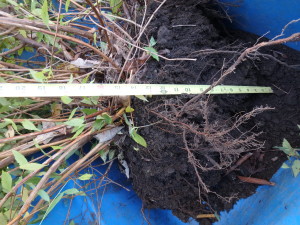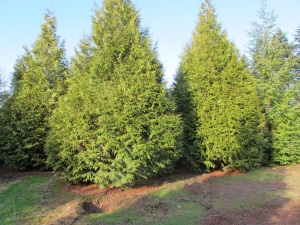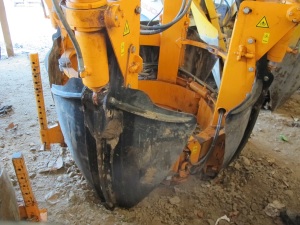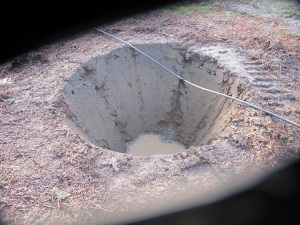Moving Trees and Shrubs
I recently fielded a query about moving a shrub: was this a good time to do so, or would the spring be better? I responded that either was all right, but that spring might be better. There is no clear answer among experts, some favoring spring, some fall.
I know from my readings that scientists have determined trees and shrubs use photosynthesis to create and store excess carbohydrates in their roots during the summer, and then use them to extend their roots in the fall. They do this even after leaf drop, only stopping when the ground freezes. This would lend credence to those who say, “Plant trees in the fall.”
On the other hand, it is already late October, so plants moved now have less time to get established than those moved or planted in the spring. I wouldn’t want my shrub to get pushed up by freezing and thawing of the soil. The downside to planting in the spring is this: most of us are not likely to remember to water a new planting every week, and dry times can damage plants that have not settled in.
Despite all that, I recently moved a shrub that had gotten too big and was crowding a rhododendron next to it. The shrub, a pink spirea, had been in the ground about a decade, and was now about 5 feet tall and wide.
My favorite tool for digging up large plants is a drain spade. This is a shovel with a long, narrow blade – business end is 16 inches long and just 5 or 6 inches wide. It allows me to get under the shrub, severing roots and giving me leverage to pry it out of the ground.
Most shrubs have roots that are in the top 6 to 12 inches of soil, and this spirea, a tough and tenacious plant, had roots down a full 12 inches, perhaps more. I pushed the blade of the spade in under the shrub at a 45 degree angle, doing this repeatedly as I moved around the plant. I was able to get my spade under the center of the shrub, and each time I tipped the spade back, lifting the root ball a little. Eventually I was able to tip the spirea over onto its side and roll it out of the hole.
I measured the root ball so that I could dig an appropriate-sized hole in the new location. The root ball was 12 inches from top to bottom and about 2 feet from side to side – and weighed at least 50 pounds, I would estimate.
Whether planting a new tree or shrub or moving one, it is important to dig a hole just the depth of the root ball, not deeper. The new hole should be about 3 times the width of it. The reason for a wide hole is to allow roots to spread more easily and get well established more quickly. In my case I did not dig a 6-foot wide hole as the soil was not compacted, but loose and fluffy.
If I had been planting the spirea on a lawn with compacted soil, I would have loosened the soil in a wider zone. Even so, my hole was 4 feet wide or twice the width of the root ball. I dug a hole with a flat spot 12 inches deep for the roots and with sloping sides.
It is also important to plant a tree or shrub with the same compass orientation that it had before you bought it. For purchased trees, look for the least leafy side – that is generally the north side. The trunk of the north side, if planted facing south, can be sunburned or scalded by the winter sun. That is less a problem for multi-stemmed shrubs.
I don’t recommend giving fertilizers to trees and shrubs. I don’t want to force any fast growth, particularly now, nearing winter, and even a slow-release organic fertilizer will contain nitrogen (which pushes green growth). I do give my trees some rock powder – Azomite is a brand name of a bagged mineral powder I use. It contains many micronutrients that may not be in my soil, but no nitrogen. I added Azomite and some ground granite dust to the soil before I planted the spirea.
The final touches to this job were to water it well, helping it to settle in and getting rid of air pockets which can damage roots. Lastly, I spread a 3-inch deep layer of all-natural ground hemlock bark around the shrub. This will keep the soil warm longer, allowing my shrub to keep extending its roots. And I’ll try to remember to water it next summer if we have dry times.
Henry is the author of 4 gardening books. You may e-mail him at henry.homeyer@comcast.net or write him at P.O. Box 364, Cornish Flat, NH 03746. See Henry’s regular blog posts at https://dailyuv.com/
Winter Planning: What Size Tree to Buy?
The snow is deep, the temperatures well below freezing. It’s a good time to think about what projects to undertake this year. My friend Evan Schneider, who was in the Peace Corps with me in Cameroon, recently bought a house in Portland, Oregon. He and his wife are retired and realized that whatever landscaping they do, they don’t want to wait 20 years for a shade tree to actually produce enough shade for the two of them to sit in the shade all afternoon reading good books.
In general, I buy the smallest tree available, not the largest. I know that a small tree loses a smaller percentage of its roots when it is dug up for transplanting. Or if it has been growing in a plastic tub, I figure the less time it is in that tub, the less time the roots have to encircle the pot and get tangled. So I was surprised that they had purchased a thirty-foot tall maple tree, and had it installed. I visited them recently, and saw that the tree seems to be thriving.
Evan took me to meet the people who had done the job. The company is called Big Trees Today, in Hillsboro OR, and they specialize in growing big trees in the ground, and then digging them up and installing them. Dan Hickman, the owner, is now in his mid-thirties and is selling some trees that he planted when he was in junior high school (and working for his dad).
Dan said they generally buy small, bareroot trees, plant them in the ground, and then move them 3 times before selling them. After a tree is about 2 inches diameter it is dug up and moved. Digging it up means that the roots are severed, which stimulates new roots to grow and to branch out from the older roots. Then when the trunk is about 5 inches in diameter, it is dug up and moved again. Finally at 9 inches in diameter it is moved for the final time before it is sold. Depending on the kind of tree and how fast it grows, it might be root pruned again without digging it up – by digging down and severing roots.
I once moved a crab apple tree for a woman who had planted it when her son was born. She and her family were moving, and wanted to move the tree, even though her son was, by then, twelve years old (I think). I told her I could do it as a two-step process: First, I would cut the roots along a dotted line about two and a half feet from the trunk. I alternated thrusting the shovel deep into the soil and leaving a shovel-width undisturbed. I did that in the fall, I believe, and then moved the tree the next year. When it was time to dig it up, I dug around the tree three feet from the trunk. That way the previously severed roots had been given time to fork out and grow new feeder roots which were largely undisturbed when I moved it.
Most commercial firms that move trees have a special tractor-mounted tool called a tree spade. It is fitted around the tree and several big blades are hydraulically powered to slice deep into the earth creating a root ball that is shaped a bit like a huge ice cream cone (though not as pointy).
Dan Hickman told me that it is important that the root ball not fall apart during the digging, the transporting, or the planting. His firm is located where the soil is high in clay, which helps the root ball stick together, especially if kept moist. But they also wrap the root ball, first in an open wire cage, then in burlap.
I have seen trees with root balls wrapped in synthetic burlap, which must be removed at planting time. I once dug up a tree that was 7 years old and was not growing well, only to find that its roots were encased in burlap that had not broken down. Dan Hickman said the burlap they use disintegrates in 3 to 4 months, and they leave it in place. Only after it is planted do they cut away any burlap they can at the soil surface. Me? I’ve always removed the burlap.
I asked Dan what was the biggest tree he ever moved. He told me that they once moved an historic camperdown elm (Ulmus glabra ‘Camperdownii’) that was 106 years old but in the way of an upcoming building project. It had a rootball 16 feet wide and it weighed 73,000 pounds – over 36 tons! He and his crew root pruned it in the spring, and then dug it up and moved it in the fall. It is doing fine.
What else should you know about buying a big tree? Find a company that has plenty of experience. A company that has invested in a tree spade is probably a good bet, though it can be done by hand. Be sure to have the tree planted at the right depth – you will want it to sit with its trunk flare exposed, not buried.
Set up a watering system so that your big tree never gets thirsty. Digging a big tree severs roots, even if it has been root pruned and has a compact root system. A transplanted tree has fewer root hairs to pick up water and minerals. It makes sense to use a timer that will turn on your watering system on a schedule. You can use a soaker hose or an irrigation system with emitters to deliver the water. It will require more water in the heat of August than in the spring or fall, so will have to adjust it accordingly.
Finally, create a “donut” of bark or wood chips around the tree, covering the roots, but not touching the trunk. Mulch will keep down weeds and grass, and keep those dudes with weed whackers away from the trunk. You don’t want the bark damaged, and string trimmers or lawnmowers can be lethal.
So I’ve re-thought my position about planting big trees. I’m not exactly a spring chicken anymore, so if I want to see another mature tree on my property, I’ll consider buying a big tree. And maybe even having an expert – with the right tools – install it.
Henry lives in Cornish Flat, NH and is a UNH Master Gardener. His Web site is www.Gardening-Guy.com. He is the author of 5 books.






